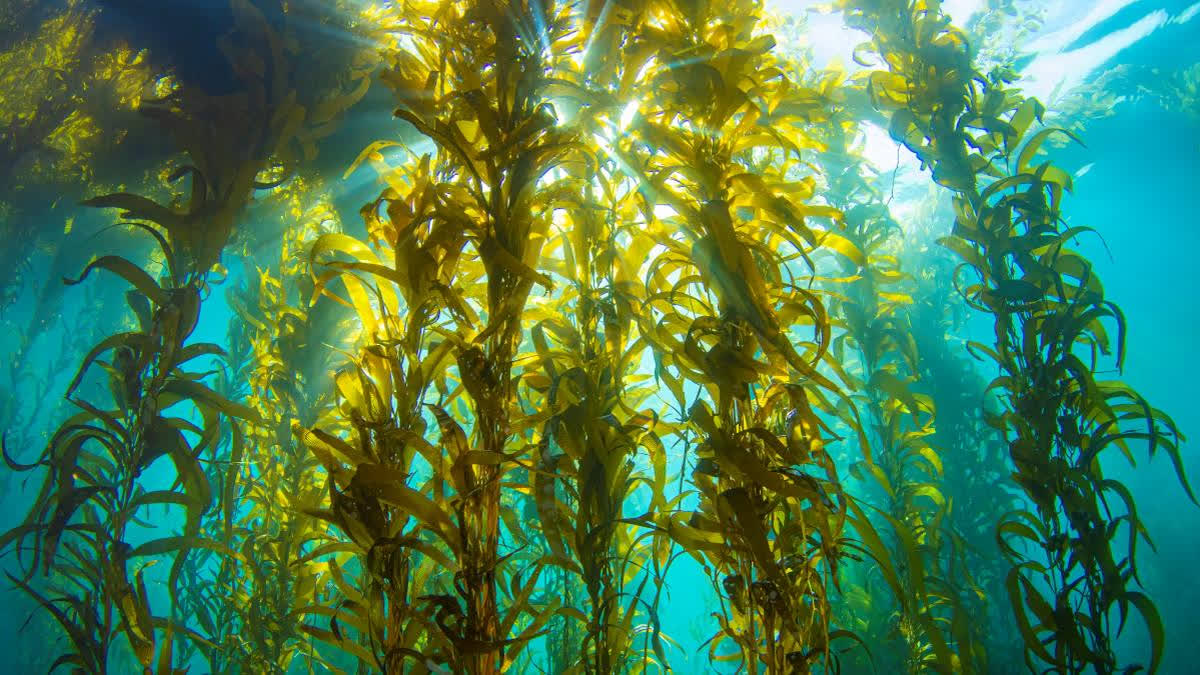New Delhi: Seaweed farming has the potential to deal with climate change impact, simultaneously its rich properties help cultivators to get better financial returns by selling as its biomass has multiple nutritional and medicinal values to be used in the pharmaceutical and food industry.
As per the Indian Council of Agricultural Research (ICAR), seaweed farming is a green technology with zero input which can act as an important mitigation measure for reducing the adverse impact of climate change and has the potential to earn carbon credits for the county.
Assistant Professor, Marine Biotechnology, Gujarat Biotechnology University, Dr Nitin Trivdi told ETV Bharat, "The seaweed farming is helpful to deal with climate change as these are photosynthetic plants which absorb CO2 from the environment for their growth. Second, it helps mitigate ocean acidification by absorbing CO2 from the ocean and increasing the pH of the seawater. These processes improve the environment and reduce the impact of climate change on marine ecosystems.”
"In order to address climate change issues, the ICAR-CMFRI, and CSIR-Central Salt and Marine Chemical Research Institute have identified potential sites for seaweed farming in 9 coastal States and 4 Union Territories of the country. The sites identified (384) were categorised into green zones (3999.37 ha), amber zones (14,076.77 ha), and blue zones (6,631 ha), with 24,707 hectares identified as suitable for seaweed farming," Indian Council of Agriculture Research annual report 2023-24 states.
Seaweeds have industrial importance due to the presence of sulphated polysaccharides like agar, algin, and carrageenan. Further seaweeds are rich in minerals which makes them a potential source of biostimulants. He said, "Seaweeds are a rich source of bioactive components which has applications in pharmaceutical, nutraceutical, cosmaceutical, food and agriculture industries".
United Nations Environment Programme Report 2023 says:
The Environment Programme (UNEP) recognises the growing global interest in seaweed farming as a potentially scalable ocean-based solution to climate change that may provide environmental and social co-benefits as part of the advancement of resilient and climate-smart aquaculture. As per the report, seaweeds absorb pollutants (nutrients including nitrogen phosphorous and heavy metals) in coastal waters.
UN Trade & Development:
Within a sustainable ocean economy, seaweed collection, culture, processing, and trade are one of the sectors with the most opportunities to achieve sustainable growth by 2030. Seaweed farming culture is closely linked to food security, income, livelihoods, and traditional knowledge of rural coastal communities, particularly for women and Indigenous Peoples.
Government’s initiative:
In a significant move, the Centre has notified the ‘Guidelines for Import of Live Seaweeds into India’. This initiative aims to bolster the development of seaweed enterprises as a key economic driver for coastal villages, ensuring livelihood sustainability and socio-economic upliftment of the fisher community while upholding environmental protection and biosecurity concerns at the core of all actions. Pradhan Mantri Matsya Sampada Yojana (PMMSY), the flagship scheme of the Government of India envisaged to revolutionise the seaweed sector, aiming to increase seaweed production of the country by over 1.12 million tonnes by 2025.
National Fisheries Development Board:
Some 844 species of seaweeds have been reported from Indian seas, their standing stock is estimated to be about 5,715 tonnes (wet weight). Among them, 221 species are commercially important and abundant along the Tamil Nadu and Gujarat coasts and around Lakshadweep and Andaman & Nicobar Islands. Rich seaweed beds occur around Mumbai, Ratnagiri, Goa, Karwar, Varkala, Vizhinjam and Pulicat in Tamil Nadu, Andhra Pradesh and Chilka in Orissa.
ICAR Report:
Seaweeds have a variety of commercial applications in food, pharmaceutical, cosmetics and mining industries. India has a seaweed production potential of 9.88 million tonnes wet weight per year while the current production stands at merely 52,107 tonnes wet weight per year. Keeping in view the immense potential of seaweed farming in the country, ICAR-CMFRI has brought out a document on good management practices to promote and support the sustainable farming of seaweeds in India.
What seaweed farmers say:
Abla Bhai Waghel, who is a Seaweed farmer, is a witness of significant transformation in his life after engaging in seaweed farming as selling seaweed biomass has improved his financial condition as well as skills to increase productivity in this sector.
Satisfied with his significant growth, Abla Bhai of Gujarat’s Kutch coast area told ETV Bharat, "I was earlier in traditional fishing where I hardly managed to earn daily bread and butter for my family. Then it decided to shift my focus on cultivating seaweed which has now proven a boon for me in terms of financial point of view."
"I harvest seaweed five times in a year and get around 200-300 kgs of produce which depends on climate and weather conditions in a circle. Now, I promote my product online and earn more by selling it to pharmaceutical-related persons," he added.
Altaf, a seaweed farmer of Gujarat, told ETV Bharat, "I have been in this field for the past two years and getting benefit from the produce. But last time heavy rainfall disturbed the normal situation only. Initially, the farmers have to invest in equipment like bamboo, rope and others and start their farming."
Training facility:
Dr Nitin Trivedi informed that a proposal has been submitted to GSBTM, DST-Goverment of Gujarat to provide onsite training for seaweed cultivation at various coastal areas of Gujarat to strengthen the seaweed cultivation and research as Gujarat is blessed with a 1600 km long coastline. "We have a plan to provide training to a group of 25-30 coastal community people," he said.
Farmers face Challenges:
The farmers have to deal with several issues including a lack of proper marine spatial plans, worst weather conditions, natural calamities, financial conditions, crop loss due to high temperatures and some other issues.



